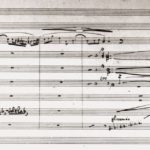It can be said of beauty in the arts that the simpler something appears to a beholder, the greater were the creator’s efforts in cloaking the underlying complexity of their creation.
Subtlety, after all, requires a keen eye for detail. Such is the case with Claude Debussy’s Prelude a L’apres-midi d’une faune, a symphonic poem that some consider to be the definitive turning point in the evolution of modern music. Translated as “Prelude to the Afternoon of a Faun”, its enduring fame rests squarely on the piece’s ability to ebb and flow harmonically without losing the passionate purpose and endless curiosity of its flute-playing goat-legged protagonist.
 Shying away from musical literalism, the layering of the orchestration and tickling lilt of the flute’s melodies imply a delicate balance between romantic discovery and cheeky flirtatiousness. This is done primarily as a tribute to the prelude’s inspiration, a poem by Stephan Mallarme of scandalously erotic proportions (at least, for the time in which it was written).
Shying away from musical literalism, the layering of the orchestration and tickling lilt of the flute’s melodies imply a delicate balance between romantic discovery and cheeky flirtatiousness. This is done primarily as a tribute to the prelude’s inspiration, a poem by Stephan Mallarme of scandalously erotic proportions (at least, for the time in which it was written).
Depicting the musing mid-day sojourn of a fawn as he awakes after mingling with his very friendly nymph and nyad neighbors, the story drifts on a current of bubbling flute solos which deliver an intoxicating feeling of otherworldly calm. Punctuated by swelling ascending passages, the final product portrays a metaphor of the human psyche: a beacon of child-like wonder, part rationality and part instinct that lives to investigate and enjoy all that the external world has to offer.
The piece’s musical impact was astronomical, with daring compositional choices being pioneered from its very first performance at Paris’s Salle Harcourt in 1894. Repeating cells of

music with no real direction, flute solos beginning (unfingered) on the “bad note” of C# that flautists ordinarily stampede away from, and a chordal structure functioning as something of an afterthought in comparison to the unabashedly forward role of its principal soloist. Each of these bold decisions converged into a piece of music which cranked up the heat on a musical revolution that already started to brew, a way of interpreting music through the conviction that it can be so much more than a static phenomenon defined by timeless truths and classical principles.
At a time where social distancing, mask-wearing, and household bubbling have made us all increasingly wary of environmental interaction and exploration, Debussy’s Prelude a L’apres-midi d’une faune serves as a musical reminder of the scintillating pleasures that await us in this garden of life. All we need to do is awaken from our slumber and take it all in, one hoof-step at a time.
Hear the SSO perform this work as part of our Postcards from Paris!
[button link=”https://saskatoonsymphony.org/event/opening-night/”]Postcards from Paris[/button]


